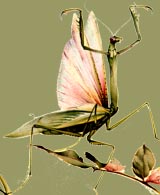 |
 back back   next next
Insects and Biodiversity
Insects and People
Insect Characteristics
|
|




INSECT CHARACTERISTICS
METAMORPHOSIS
Growing Up
Simple Metamorphosis
 There are two kinds of metamorphosis, simple and complete. With simple metamorphosis, the immature stages are called nymphs and they are usually quite similar to the adults in appearance. The nymphs are smaller than the adults and they have less developed wings and sometimes the colour is different. In some groups of insects with simple metamorphosis, the nymphs are aquatic and extract oxygen from the water by means of gills. In these groups the adults are terrestrial and quite different in appearance. In simple metamorphosis the wings, if present, develop externally during the juvenile stages. There are two kinds of metamorphosis, simple and complete. With simple metamorphosis, the immature stages are called nymphs and they are usually quite similar to the adults in appearance. The nymphs are smaller than the adults and they have less developed wings and sometimes the colour is different. In some groups of insects with simple metamorphosis, the nymphs are aquatic and extract oxygen from the water by means of gills. In these groups the adults are terrestrial and quite different in appearance. In simple metamorphosis the wings, if present, develop externally during the juvenile stages.
Complete Metamorphosis
 In insects that undergo complete metamorphosis, the juveniles are worm-like larvae that differ greatly in appearance from the adults of the same species. The larvae do not have compound eyes; they may be legless or have legs as well as having leg-like appendages on the abdomen. They usually have chewing mouthparts, even in the groups in which the adults have sucking mouthparts. In complete metamorphosis, the wings develop internally during the juvenile stages and appear externally only during the resting stage that precedes the final molt. In insects that undergo complete metamorphosis, the juveniles are worm-like larvae that differ greatly in appearance from the adults of the same species. The larvae do not have compound eyes; they may be legless or have legs as well as having leg-like appendages on the abdomen. They usually have chewing mouthparts, even in the groups in which the adults have sucking mouthparts. In complete metamorphosis, the wings develop internally during the juvenile stages and appear externally only during the resting stage that precedes the final molt.
During this resting stage, the insect is called a pupa or chrysalis. The pupa does not move around, it does not feed and it is extremely vulnerable to predators and parasites. Therefore, a cocoon or some other protective structure often covers them. A large amount of internal reorganization of the insect's body takes place while it is a pupa or chrysalis. More than 90% of the insects display complete metamorphosis in which the juvenile stages and adult stages live in distinct habitats. When juveniles and adults live in different habitats, feed on separate foods and are dissimilar in form, they do not compete directly for the same resources. This is an advantage to the species that have complete metamorphosis.
 Back to top
Back to top

|